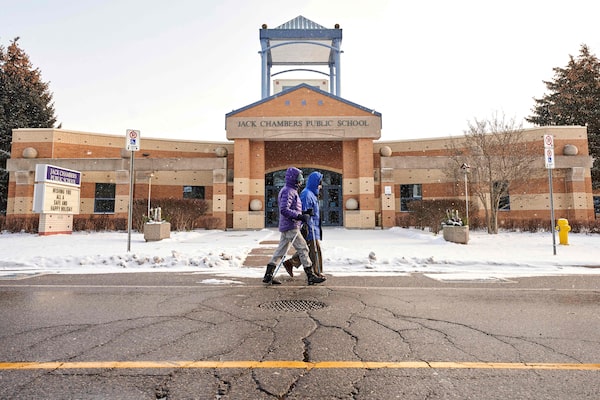
A couple walks past Jack Chambers Public School in London, Ont., on Jan. 6.GEOFF ROBINS/AFP/Getty Images
As the Omicron wave surges, should schools remain open or be closed?
That’s one of the most fiercely debated questions across Canada and around the world as we enter year three of the pandemic.
But it’s the wrong question.
Of course, schools should remain open.
At the very least, they should be the last thing to close, because they are as essential as grocery stores and hospitals.
Children need to learn, to socialize, to play, for the sake of their development, and their physical and mental health. Their parents need to work.
How dare we tolerate school closings while still allowing in-person dining, nail salon manicures, professional sporting events and so much more? (Depending on the province, of course.) We need to get our priorities straight.
The question we should be asking ourselves is not “should school remain open or be closed?” It’s: “How can we best protect children from the ravages of the pandemic?”
Trying to prevent children from being infected is important, even if they do appear to have less severe outcomes. So too is protecting kids from collateral damage, like the mental health effects of isolation.
School is an anchor for children and youth. It’s where, in normal times, young people spend a good chunk of their lives from ages 4 to 18, and often beyond.
We should, as much as possible, try to maintain the educational routine, the comforting normalcy of daily school attendance.
Outbreaks have and will occur in schools. But there is no good evidence that, in jurisdictions that kept schools open, young people suffered more harm, such as higher rates of hospitalization. Maybe the highly infectious Omicron variant has changed that calculus, but it’s unclear.
One of the great unknowns is, when we do close schools, what do young people do? It is doubtful that most stay in some sort of protective bubble, free of virus exposure.
Schools offer the opportunity to create a more controlled environment, one where precautions can be taken: Vaccination, masking, ventilation, testing, physical distancing.
Of course, none of these measures will be implemented perfectly. We can’t wait for every safety measure to be in place before children return to bricks-and-mortar schools.
However imperfect, in-person instruction is the least-imperfect approach we have. It’s also the most equitable.
Online learning is not, in itself, harmful. But it’s inadequate, and often unfair. A lot of children don’t have access to high-speed internet, to a quiet place to do their schoolwork, and to parental oversight.
Every parent who has endured online learning knows it is an enormously stressful time-suck, and exponentially so if you have more than one child. But it’s more challenging for parents who can’t work remotely. The economic effects cannot be dismissed.
School opening and closing policies have varied enormously across the country. There is little doubt everyone, from politicians to public-health officials, are well-meaning.
Still, there has been a lot of dubious decision-making.
Some jurisdictions, like Ontario and Quebec, have out of an abundance of caution delayed school reopening. Temporary closings are okay (if you ignore that they are crazy-making for parents) but the provinces don’t seem to have used this extra time to actually make classrooms safer, so what exactly is the point?
The extra time could have been used for a number of initiatives: a childhood vaccination blitz (first dose coverage for kids 5 to 11 ranges from an abysmal 38 per cent in Alberta to 70 per cent in Newfoundland and Labrador); prioritizing booster doses for teachers and staff; getting more HEPA filters into schools; securing supplies of N95 masks for educators; and developing metrics for further action (at what point do you close a school – when 5 per cent, 10 per cent or 20 per cent of kids are out sick?).
Other jurisdictions that rejected online learning in favour of in-person learning, like B.C. and Alberta, have undermined the wisdom of the decision with some questionable policies like refusing to test and trace and limiting isolation after potential COVID exposure. Pretending that COVID-19 doesn’t exist or matter is ludicrous. Metrics matter in every province.
So too is claiming that school opening/closing is having an irreversible impact on children and youth’s mental health. Young people are incredibly resilient and we shouldn’t be pathologizing their normal emotions to score political points.
What we need to do is openly discuss the risks and benefits of schooling, online or in-person. There are many unknowns, so finding the balance will sometimes involve going with our gut.
Most of all, we need to stop paying lip service to the well-being of young people and failing to pay attention to the details that matter.
Keep your Opinions sharp and informed. Get the Opinion newsletter. Sign up today.
 André Picard
André Picard